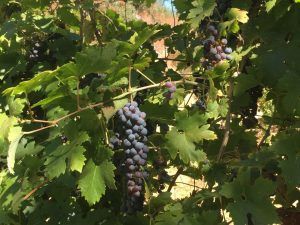When Grape Pests Attack
A friend recently asked me what to do about leaf hoppers. She had done her research and identified the pest as Virginia Creeper Leafhopper. They were so numerous she didn’t like being around her vines; she is not alone. Farm workers have refused to harvest grapes with heavy infestations. Unfortunately, by autumn there is very little to be done.
The first thing many people think of is to “Go Nuclear” or use chemical insecticides. I would never consider this option. There are other ways.
Grape vines can tolerate up to five leaf hoppers per leaf. Vines are hardy. The easiest method of control is good vineyard hygiene. Keep the area around your vines clean and clear of the debris that so often allows insect pests to overwinter.
That starts with pruning. Most of us leave too many canes on the vine when we prune. Later in the year, this reduces air circulation under the vine canopy and provides a perfect home for pests. Prune for openness and in the correct way for your variety of grape.
Once you have pruned, clean up immediately. Either burn or throw out canes and leaves. Rake and dispose of any weeds growing under the vines. Bare earth is best at this stage. Debris provides a primary place where insects and other pests will over winter. While they also can hide in the bark of the trunk and canes needed for next year’s growth, proper pruning and disposal eliminates the majority of pests. Keep it clean!
After bud break in the spring, watch for developing insect pests. They can be easily controlled in the larval stage (rather than the very mobile adults or masses of eggs they lay later). Use insecticidal soap and agricultural oils, yes, even for leaf hoppers! Later control requires pesticides that also kill all of the beneficial insects that are truly our friends.
A second problem is the Grape Leaf Skeletonizer (Harrisina americana in the eastern U.S. and Harrisina metallica in the West). The caterpillars – yellow with black and purple bands – can eat outward from their hatching site like a pillaging army. By second hatch, they can leave an entire vineyard with only the skeletons of leaves hanging on the vines. They can be controlled with Bacillus thuringiensis or diatomaceous earth.
Also watch for powdery mildew. This is especially a problem if the canopy is too dense. Prune all canes a foot off the ground in mid-summer to increase air circulation. If pruning does not control mildew, dust with sulfur powder. Rain and high humidity are the enemies here. If it rains, dust again!
Good air circulation is extremely important. It not only prevents a lot of diseases but helps beneficial insects keep other insects at bay. Rake and remove leaves each fall; pick up and compost fallen fruit. Annual pruning keeps the canopy from getting too dense. After pruning, remove cuttings. A clean vineyard is a healthy vineyard. Start your vines off right this winter.
Jim Bliss is a University of California Cooperative Extension Master Gardener of Tuolumne County.

